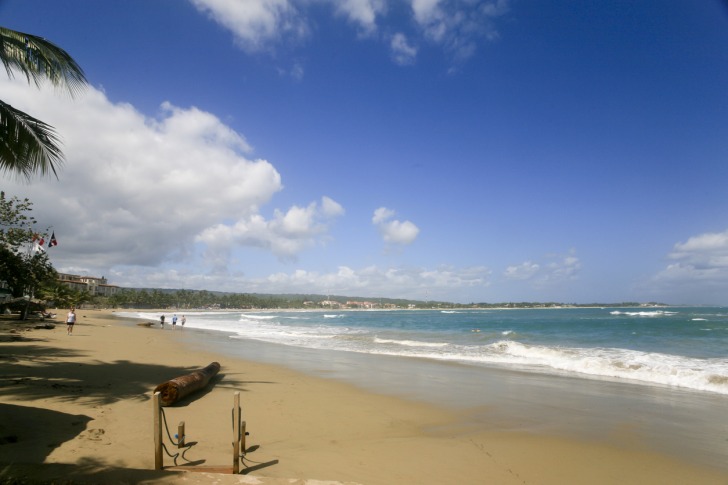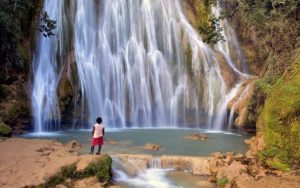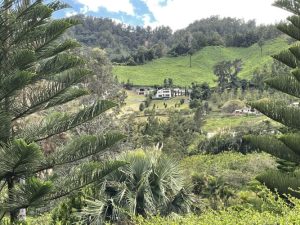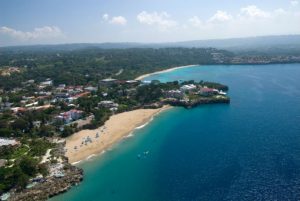 Dominican Republic : Safety by City
Dominican Republic : Safety by City
Dominican Republic - safety as a country Cabarete, Dominican Republic is well known for its island vibe, water sports, and beautiful beaches.
Before you pack your bags, it’s natural to wonder if it’s a safe place to visit.
We’ll dive into the safety of Cabarete, and what to know before you go.
Warnings & Dangers in Cabarete

OVERALL RISK: MEDIUM
The Dominican Republic does have its dangers. In fact, the UK has issued a travel warning about the country. They state that crime is high, including violent crime. This may apply to some areas of the Dominican, but like any country, some areas are much safer than others. Cabarete is a tourist destination, and is considered very safe. As long as you stay near the resort or tourist area, you can feel secure.

TRANSPORT & TAXIS RISK: MEDIUM
Public transportation in the Dominican Republic can vary widely in safety. Taxis and motorbike taxis can be in poor condition, and drivers may be unskilled. Public buses and ‘carros publicos’, which are cars that pick up multiple passengers, are often poorly maintained. Roads outside tourist areas can also be in poor condition, and driving conditions can be dangerous. However, registered providers and authorized airport and hotel taxi services are safe.

PICKPOCKETS RISK: HIGH
Pickpocketing tends to occur in populated areas, and areas with lots of tourists are popular targets. Violent crime in Cabarete is rare, but you will need to be on the lookout for pickpocketing. Be sure to take precautions to keep your valuables safe when you are out in Cabarete or even in the hotel or resort.

NATURAL DISASTERS RISK: MEDIUM
Hurricanes are a risk anywhere in the Caribbean during hurricane season, which is June through October. However, damage in Cabarete is typically mild. Other risks include earthquakes, heat waves, tsunamis, and flooding.

MUGGING RISK: LOW
Mugging is very uncommon in Cabarete. It's a safe tourist destination, so muggings are very rare.

TERRORISM RISK: LOW
The risk of terrorism in Cabarete is low. The Dominican Republic is not known for terrorist attacks. However, civil unrest is a possibility in the country.

SCAMS RISK: MEDIUM
The risk of serious scams is not high in the Dominican. However, you may run into taxi drivers, restaurant owners, and other businesses who try to overcharge tourists. As long as you know what you should pay, you should be fine. It's also important not to flash your cash because this can make you a target.

WOMEN TRAVELERS RISK: MEDIUM
Women travelers can feel safe in Cabarete, as long as they take reasonable precautions. Most people in the Dominican are friendly and tolerant. Sex crimes in the Dominican are no higher than in most countries and rare in Cabarete.

TAP WATER RISK: HIGH
In general, the tap water in Cabarete isn't safe to drink. However, bottled water is very cheap there. If you are in a hotel or resort, the tap water may be safe, but you'll want to ask beforehand. Most accommodations use water from large bags for preparing food and drinks, which is safe. However, the tap water may contain microbes that make you sick. When outside your resort, only drink bottled water. It's also a good idea to not order drinks with ice, because the ice may contain contaminants as well.
Safest Places to Visit in Cabarete
The resorts in Cabarete are considered very safe.
You will need to be cautious if you travel outside of the resort.
However, most areas are safe.
Just stick to well-lit and populated areas.
The beaches are also considered safe.
Other areas of the Dominican that are safe to visit include the Damayagua Cascades, Terrenas, Samaná, Puerto Plata, and Los Haitises National Park.
Places to Avoid in Cabarete
Cabarete is safe.
However, you will want to avoid places that are sparsely populated.
Other areas of the Dominican Republic are less safe.
Crime, including violent crime, is a concern in Santo Domingo.
La Duarte, a street in Santo Domingo, should be avoided.
Other areas to avoid include Arroyo Hondo, Naco, and Gazcue.
Safety Tips for Traveling to Cabarete
- Avoid Carrying Large Amounts of Cash. You’ll want to avoid carrying large amounts of cash when you are out and about. You should also avoid carrying or wearing valuables. The Dominican is a poor country, and crimes of opportunity do occur. If you have lots of cash, or even look like you do, you may make yourself a target.
- Keep Personal Information Private. Be sure to keep your personal information private while you are there. Guard your bank cards and ID cards closely. Don’t leave any personal documents out in your hotel room.
- Beware Rip Currents. Cabarete’s beaches and bay are generally safe. However, rip currents do occur. Rip currents will look like a brown streak. They are narrow and will push you out to sea if you get caught in one. Deaths occur when a swimmer attempts to swim directly back to shore. You can’t fight against the current. It’s like attempting to go down a fast-moving escalator traveling up. To get out of a rip current, you’ll need to swim parallel to shore until you get out of the current. Then, you can swim back to shore.
- Never Leave Food and Drinks Unattended. There are rare stories of tourists, particularly women, getting drugged. This can even occur in resorts. If you leave a drink unattended, get a new one. Drugs can be tasteless and render you helpless, leaving you at the mercy of the person who drugged you.
- Avoid Being Out at Night. It’s best to avoid traveling outside of the resort at night. Crime is more likely to occur during night hours. If you must leave the resort, be sure that you have a group of people with you.
- Travel as Part of a Group. It’s a good idea to travel as part of a group, rather than solo. There’s safety in numbers. You are less likely to be the victim of a crime if you aren’t alone. This also allows someone to notice if you disappear. If you are alone, it can be days before anyone knows you are missing.
- Don’t Use Your Phone. Phones are a prime target for thieves. If you need to check your phone, go into a restaurant or store. Most thieves are on motorbikes. They will grab your phone while driving by. This is why it’s much safer to use your phone in a building, rather than on the street.
- Take Mosquito Precautions. When you are in the Dominican Republic, you’ll need to be careful of mosquitos. In the U.S., these bugs are rarely more than a nuisance. However, in the Carribean, they can carry diseases including dengue fever, Zika and chikungunya virus. You’ll need to wear long sleeves and pants in mosquito-prone areas and sleep with a net. Insect repellents are also a must to stay safe and healthy.
- Don’t Use Unlicensed Taxis. Never use an unlicensed taxi. They may not be well maintained and the drivers aren’t always skilled. You can differentiate a licensed taxi because it will have a sign on the roof that has the name of the taxi company.
- Hold On to Personal Belongings. Never leave your belongings unattended. This essentially invites someone to steal them. Cross-body bags are safer than purses because purses are easily snatched. When you are outside your room, carry only what you truly need with you. This makes it easier to keep up with and reduces the odds of your items being stolen. Any valuable or personal items that are left in your room should be stored in a safe. Never leave them in plain sight in your room. You may want to consider anti-theft clothing, including underwear, shirts, and even scrunchies with hidden pockets. This greatly reduces your risk of being pickpocketed.
So... How Safe Is Cabarete Really?
The U.S. lists the Dominican Republic as level 2, which means you should use increased caution when visiting.
However, Cabarete is much safer than most of the country.
You can feel safe visiting Cabarete, as long as you follow some basic precautions.
How Does Cabarete Compare?
| City | Safety Index |
|---|---|
| Cabarete | 53 |
| Punta Cana | 64 |
| Santo Domingo | 31 |
| Sosua | 77 |
| Samana | 78 |
| Playa Rincon | 64 |
| Jarabacoa | 54 |
| Melbourne (Australia) | 80 |
| Montreal (Canada) | 81 |
| Sydney (Australia) | 80 |
| Santiago de Chile (Chile) | 71 |
| Vienna (Austria) | 88 |
| Hong Kong (China) | 70 |
Useful Information

Visas
If you are a U.S. citizen, you won't need a visa to enter the Dominican Republic as long as you are staying 30 days or less. However, you will need a passport that is valid for the duration of your stay, and at least one empty page. You'll need to pay $10 for a tourist card. You can get this online or at the port of entry. This is generally covered in airline ticket fees. When leaving the Dominican Republic, you'll need to declare any amount of cash over $10,000.

Currency
The currency of the Dominican is the Dominican Peso. U.S. dollars get a favorable exchange rate, which can make visiting Cabarete less expensive to visit than other Caribbean destinations. Many businesses, particularly airlines and resorts, will take U.S. dollars. However, it's a good idea to have some pesos on hand as well. You'll get the best exchange rate by visiting a major bank in Cabarete. You can also exchange currency at your resort or ATMs, but you won't get the best rates.

Weather
Cabarete has a hot tropical climate. The average temperature ranges from 69 to 89 degrees. Temperatures rarely fall below 66 degrees or get higher than 91 degrees. If you plan to enjoy the beach, the best time to visit is in November through April. However, the water is warm and temperate all year round.

Airports
The nearest international airport is Gregorio Luperón International Airport in Puerto Plata. It's about 12 miles from Cabarete. This airport is very small, so getting through customs is quick. However, it's also the most expensive airport in the Dominican. The next nearest airport is El Cibao International Airport in Santiago. This airport is less expensive, but getting transportation from Santiago to Cabarete will be more expensive. Santiago is 44 miles from Cabarete.

Travel Insurance
Travel insurance isn't required when visiting Cabarete, but it's highly recommended. It will cover unexpected expenses, including medical care, lost luggage, and canceled flights.
Cabarete Weather Averages (Temperatures)
Average High/Low Temperature
| Temperature / Month | Jan | Feb | Mar | Apr | May | Jun | Jul | Aug | Sep | Oct | Nov | Dec |
|---|---|---|---|---|---|---|---|---|---|---|---|---|
| High °C | 29 | 29 | 30 | 30 | 32 | 33 | 33 | 34 | 33 | 33 | 31 | 30 |
| Low °C | 19 | 19 | 19 | 20 | 21 | 22 | 23 | 23 | 23 | 22 | 21 | 20 |
| High °F | 84 | 84 | 86 | 86 | 90 | 91 | 91 | 93 | 91 | 91 | 88 | 86 |
| Low °F | 66 | 66 | 66 | 68 | 70 | 72 | 73 | 73 | 73 | 72 | 70 | 68 |
Dominican Republic - Safety by City
| City | Safety Index |
|---|---|
| Bayahibe | 52 |
| Cabarete | 53 |
| Jarabacoa | 54 |
| Las Terrenas | 52 |
| Playa Rincon | 64 |
| Punta Cana | 64 |
| Samana | 78 |
| Santo Domingo | 31 |
| Sosua | 77 |












Killers in Cabarete DR
I was kidnapped an nearly murdered in Cabarete. I was befriended by some locals on
the beach while surfing. They managed to drug me in my own apartment and abduct me
in a fake ambulance with the police helping. They Injected my with needles with the hope that I could not escape. However I managed to escape before the injections kicked in to my legs. I was handcuffed and beat up badly. Never visit Dominican Republic if you want to live.
My captors I believe have the missing tourist “tennis player from Florida”. If anyone is interested in investigating I have videos of my Kidnapping and I can provide the location
of a man that looks like the tennis player from Florida he is in very bad condition do to the quality of like that he is being held in. He appears to be handicapped but still living.